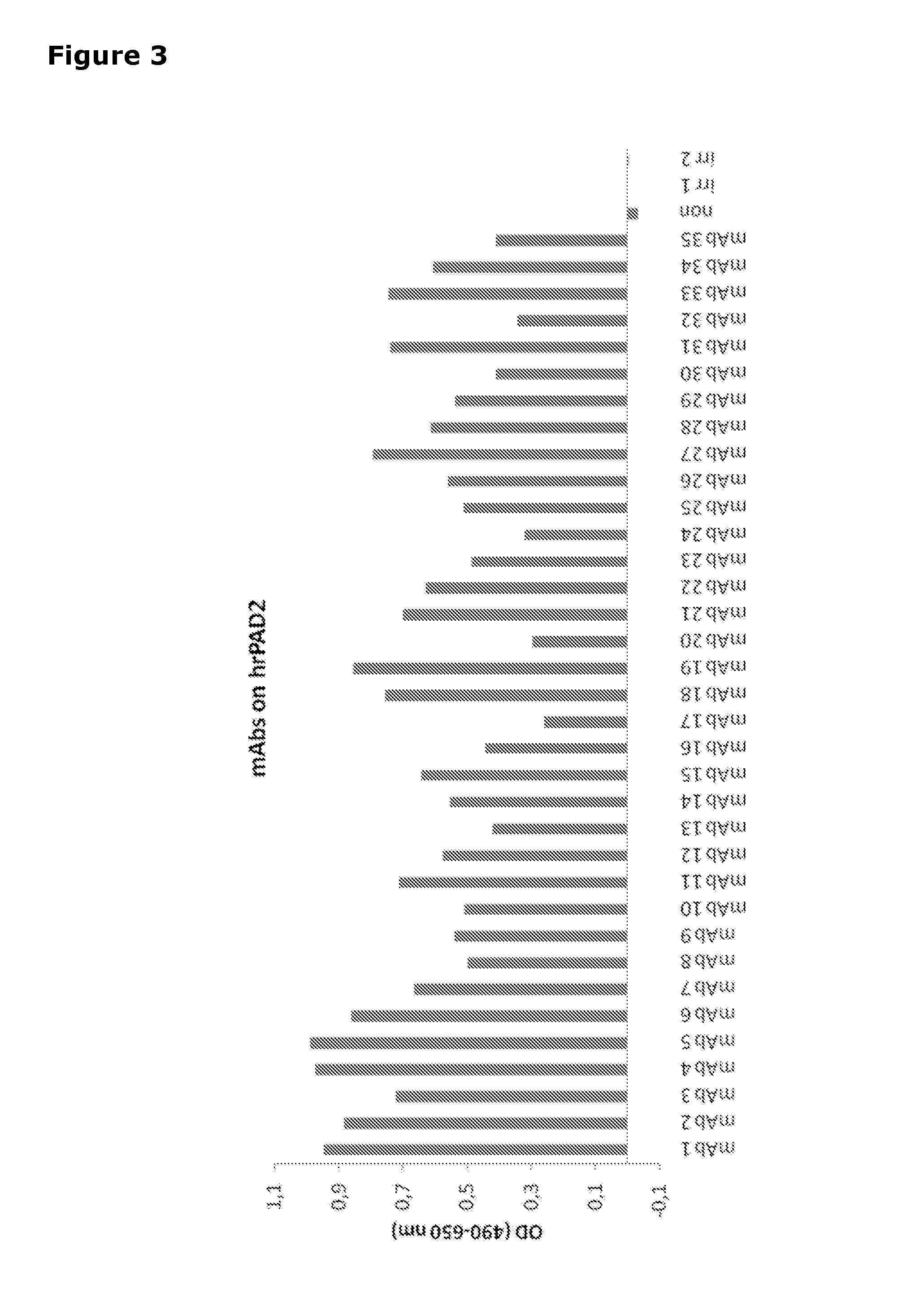Anti-pad2 antibodies and treatment of autoimmune diseases
a technology of anti-pad2 and anti-arginine deiminase, which is applied in the field of anti-pad2 antibodies and anti-pad2 antibodies, can solve the problems of protein loss, change of conformation, and increased risk of degradation, and achieves fewer side effects, inhibits pad2 activity, and increases patient compliance and safety
- Summary
- Abstract
- Description
- Claims
- Application Information
AI Technical Summary
Benefits of technology
Problems solved by technology
Method used
Image
Examples
example 1
Generation of PAD2 mAbs Directed Against Rabbit PAD2
Material and Methods
Materials
[0221]Carbazole staining solution (0.04% 3-amino-9-ethylcarbazole and 0.015% H2O2 in 50 mM sodium acetat buffer (50 mM CH3COOH, 33.75 mM NaOH), pH 5.0)[0222]Citrate / developing buffer (35 mM citric acid, 65 mM Na2PO4, pH 5)[0223]Citrullination buffer (100 mM Tris-HCl, 20 mM CaCl2, pH 7.5)[0224]Coating buffer (15 mM Na2CO3, 35 mM NaHCO3, pH 9.6)[0225]Diluting / wash buffer (PBS+0.05% Tween 20, pH 7.3)[0226]Elution buffer (PBS, 0.5% citric acid)[0227]TBS buffer (0.15 M NaCl, 0.05 M Tris, pH=7.4)[0228]Transfer-buffer (25 mM Tris, 192 mM glycine, pH 8.3, 20% ethanol)[0229]Wash buffer (sepharose cojugating) (PBS, 0.5M NaCl)[0230]Aluminium hydroxide, Alhydrogel 2.0% (Brenntag Biosector A / S, Frederikssund, Denmark)[0231]Ammonium sulfate 0.2M—PEG 4000 30% solution (Sigma-Aldrich, Brøndby, Denmark)[0232]Biotinyl-N-Hydroxy-succinimid ester (BNHS) (Sigma-Aldrich, Glostrup, Denmark)[0233]CNBr-activated sepherose 4B (G...
example 2
mAbs Cross-Reacting with Human PAD2
[0276]Materials and methods as described in example 1.
Results
[0277]In order to identify mAbs which cross-react with human PAD2 (hPAD2), different experiments were carried out (ELISA and western blotting). FIG. 5 summarizes the results obtained from the different experiments regarding human recombinant PAD2-detection and indicates which of the mAbs that bind human PAD2.
[0278]An indirect ELISA was performed to test if the mAbs could be used to detect human recombinant PAD2 (hrPAD2) in ELISA. All culture supernatants were tested against hrPAD2 in an affinity ELISA (FIG. 3).
[0279]All 35 mAbs recognized hrPAD2 in this experiment. The data from all dilutions can be seen in Table 4 below.
TABLE 4ELISA dilutionscoat-konc. (ng)50025012562.532.2515.67.83.920.970.480mAb 12.3522.1641.8741.4290.9460.5710.3050.1620.0730.0340.0170.044mAb 22.3022.1011.7891.370.8820.5130.2610.1270.0560.018−0.0020.052mAb 32.3032.0881.7381.2190.7230.3890.1710.0730.0280.0...
example 3
Epitope Mapping of Anti-PAD2
[0289]In order to identify the epitope of human PAD2 (hPAD2), different experiments were carried out. FIG. 7 summarizes the results obtained and indicates that the epitope of human PAD2 is to be found in the N-terminal part of the protein, more specifically within amino acids 1-165 (since the mAbs tested do not bind the N165 splice variant). As the epitope (often comprising 8-10 aa's) may stretch over aa position 165, being incomplete due to the splicing, the epitope is at least within aa's 1-175.
[0290]Different splice variants of PAD2 were evaluated by western blotting. Shown is the reactivity of three selected mAbs (#2, #6 and #34) with VVT (full length wild type human PAD2), C254 (amino acids 1-254 of human PAD2), 1385-463 (whole length human PAD2 without the catalytic site), N165 (from amino acid 165 to the C-terminus), N343 (from amino acid 343 to the C-terminus). The mAbs were found to bind in the N-terminal region among amino acids 1-165.
PUM
| Property | Measurement | Unit |
|---|---|---|
| concentration | aaaaa | aaaaa |
| molecular weight | aaaaa | aaaaa |
| molecular weight | aaaaa | aaaaa |
Abstract
Description
Claims
Application Information
 Login to View More
Login to View More - R&D
- Intellectual Property
- Life Sciences
- Materials
- Tech Scout
- Unparalleled Data Quality
- Higher Quality Content
- 60% Fewer Hallucinations
Browse by: Latest US Patents, China's latest patents, Technical Efficacy Thesaurus, Application Domain, Technology Topic, Popular Technical Reports.
© 2025 PatSnap. All rights reserved.Legal|Privacy policy|Modern Slavery Act Transparency Statement|Sitemap|About US| Contact US: help@patsnap.com



